|
The "One-Two Punch" Blizzard(s)
A new experience: Clearing the roofs!
-- Page 3 --
|
|
Click thumbnails below for a larger picture |
|
February 4, 2011 |
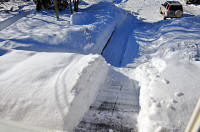 |
 |
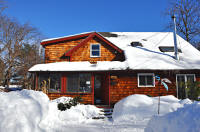 |
 |
|
Okay, with all the warnings about
roofs caving in I thought I'd check mine. Wow, much deeper than
I'd anticipated -- much . (Feb. 4, 2011) |
Reaching out through my bedroom
window, I expected to find maybe eight inches. I discovered about
eighteen! Alright, I'm impressed with the potential problem. |
I managed to cut a path, without
climbing out onto the roof. With the black roofing shingles, at least
melt should begin. |
It's a start, but more important it's a message. That
snow wave on Barbara's front roof needs to be removed. |
The
Boston Globe
Friday, February 4, 2011
Warnings, vigilance follow increase in roof
collapses
By Milton J. Valencia
A series of
life-endangering roof collapses throughout
the state — and the threat of another storm
this weekend — is prompting public safety
officials to ratchet up warnings about
structural safety and the need to take
precautions, such as having snow removed
from roofs, particularly if they are flat.
“Following several days of snow and freezing
rain, the dangers of roof collapse are
real,’’ Governor Deval Patrick said
yesterday as he announced he would seek
federal assistance. “I am urging homeowners,
business owners, and public officials across
the state to be extra vigilant for their own
safety, and for the structural integrities
of their homes and businesses.’’
More than 70 buildings, mostly flat-roofed
commercial structures, have had their roofs
partially or completely collapse under snow
and ice accumulation, or have been evacuated
because of concerns over structural damage,
said Peter Judge, spokesman for the
Massachusetts Emergency Management Agency.
He called the number of collapses
“mind-boggling.’’
Patrick asked the Massachusetts Emergency
Management Agency late yesterday afternoon
to seek eligibility for a federal physical
disaster declaration or economic injury
declaration, which would make the state and
property owners eligible for repair
reimbursements.
Students were evacuated from the Perley
Elementary School in Georgetown yesterday
after a partial roof collapse, and 20 people
were forced from a commercial condominium
building in Weymouth after a partial roof
collapse. The Lincoln Mall remained closed
yesterday after part of the roof of a
grocery market inside collapsed Wednesday
night.
And in Chelsea, an elderly woman was taken
out of her home by emergency personnel
yesterday morning after the roof of a
converted auto body garage caved in next
door, pushing in a portion of one wall of
her house and sending plates flying out of
her kitchen cabinets. She was shaken but OK,
said her grandson.
“It’s not like we are going to have a nice
melt over the next couple of days,’’ Judge
said. “I would hope that anyone who owns or
manages a big, flat-roofed building has had
someone up on the roof removing snow.’’
Officials urged anyone who suspects any
problems may be developing to call 911 and
evacuate immediately. Such quick action may
have saved dozens of people who fled a
building in Easton within minutes of its
collapse Wednesday, officials said.
While dozens of people have been put in
potentially dangerous situations,
fortunately no one has been seriously hurt,
Judge said.
Many of the buildings that have had roofs
collapse, particularly the commercial and
industrial structures, are believed to have
been built before code regulations were
enacted following a series of roof collapses
when the Blizzard of 1978 hit, said Jim
Russo, president of Russo Bar Associates
Inc., a Burlington engineering firm that
designs and builds roofs.
He said new buildings are designed to handle
heavy snowfall, but the recent mix of snow
and sleet is putting extraordinary pressure
on structures.
According to modern state building code
regulations, for instance, a flat roof must
be able to support a snow load of 31.5
pounds per square foot, and according to
engineering and meteorologist studies, Russo
said, the average density of a snowfall is 6
pounds per cubic foot.
That means it would take 5 feet of snow to
put a roof in danger of collapse.
But, given the mixture of ice, sleet and
rain the area has experienced recently, the
weight of a cubic foot of snow could be
considerably more — as much as 13 to 15
pounds — leaving roofs vulnerable to the
heavy pressure.
A building that collapsed in Revere last
week, before the Tuesday and Wednesday
storms, already had about 3 feet of packed
snow, the city’s fire chief said.
Donald O. Dusenberry, senior principal at
structural engineering firm Simpson,
Gumpertz and Heger, Inc., said that roofs —
including flat roofs — can be designed to
handle heavy snowfall. Those that are
outdated can easily be retrofitted to drain
better or reduce wind drifts, the typical
reason for a large accumulation of snow in
one area.
The main reason for the collapses is that
property owners and managers don’t clear
snow and slush from roofs or ice from
gutters, particularly, he said, after heavy
accumulation during recent storms.
“What’s happening is we’re getting a
substantial buildup of snow on these roofs,
snow after snow,’’ he said, “and 20 inches
of snow that accumulates after a series of
storms is a lot heavier than 20 inches of
snow that falls in one storm. It’s a
particular problem if you’ve got rain on top
of that snow.’’
Temperatures today are expected to reach
into the low 30s, with sunny skies. But
conditions could worsen this weekend, with
the National Weather Service in Taunton
predicting possible snowfall tomorrow
bringing a messy mix of rain beginning just
before noon and snow through the evening.
Some inland areas could see as much as 6
inches, said Neal Strauss, a meteorologist
with the weather service. Strauss said the
mostly wet snowfall will add to the pressure
already mounting on rooftops.
“It won’t take too much more to cause
additional structural issues for buildings
that already have a lot of snow accumulation
on them already,’’ Strauss said. “Obviously,
it’s a concern.’’
The wet snowfall will cause some street
flooding but should not pose a serious
threat.
As of 6 a.m. yesterday, the weather service
reported 70.5 inches of snow has fallen this
season at Logan International Airport,
compared with the average season snowfall of
41.8 inches.
Terrel Harris, spokesman for the state
Executive Office of Public Safety, said
yesterday that this winter season has been
unusual in creating this type of pressure of
structures.
“We haven’t seen sustained snow accumulation
like we are now,’’ he said.
But at the same time, state public safety
officials already have been working to
increase the required snow support limit for
roofs as part of a clean energy program.
Because green energy buildings would emit
less heat, they would be less likely to melt
snow accumulated on roofs, so the increased
weight requirement would be mandated, Harris
said.
“The newer codes are going to raise the
standards for roofs,’’ he said.
The collapses occurred mostly in commercial
buildings but also in a number of homes.
The roof of a house under renovation in
Jamaica Plain collapsed yesterday morning,
forcing the evacuation of an adjacent home.
In Reading, a homeowner and his son saw the
walls of their house crumbling and escaped
before their roof caved in.
Officials took extreme precautionary
measures yesterday in school buildings.
Besides the Georgetown school, the South
Shore Charter School in Norwell had to be
evacuated because of the roof’s condition,
Chief Andy Reardon said.
All 11 public schools in Peabody were closed
yesterday as a precautionary measure,
Peabody Superintendent Milton Burnett said.
“There were no structural compromises; it
was completely precautionary,’’ he said.
Martin Finucane of the Globe staff and Globe
correspondents Jenna Duncan and Katherine
Landergan contributed to this report.
|
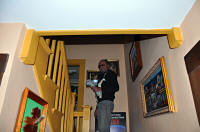 |
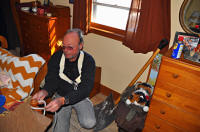 |
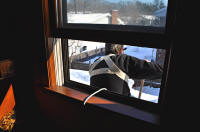 |
 |
|
We'd discussed it last night. If need be, I have the
equipment to do it safely. (Feb. 4, 2011) |
I grabbed one of my boating safety harnesses, a halyard,
my shovel, and attacked. I attached the halyard to a strong bed post,
handed Barbara the camera, and instructed her on how to keep me from
falling if it came to that. |
Squeezing out the window was the hardest part. |
Once out there, it was simply a matter of pushing that
18-20 inches (and more) of snow over the edge, without going with it. |
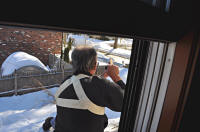 |
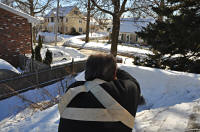 |
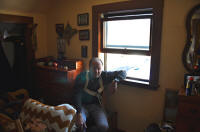 |
 |
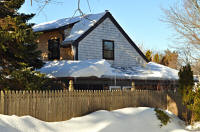 |
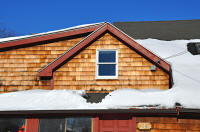 |
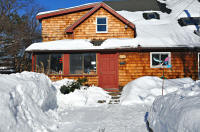 |
|
As I told her, "One hand for me, one for the boat." I
reached as far as I safely could. There was no footing -- ice beneath
snow on the shingles. |
Coming home, I realized my theory was working too -- that
the black shingles had warmed, the roof where I'd shoveled had dried,
the clearing was expanding.
New footing had arrived. |
Tomorrow I'll safely expand the clearing -- before the
next storm arrives on Saturday. |
|
CLICK THUMBNAILS BELOW FOR HIGH RESOLUTION
ENLARGEMENTS |
 |
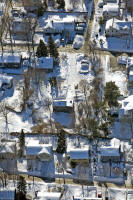 |
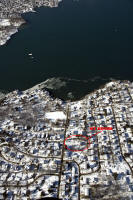 |
|
My brother John, owner of
Les Vants Aerial
Photography, shot this large format photo while flying over.
(clicking on the above thumbnails will open
large 2MB versions.) |
Above left is a shot he took of my house and lot from the front,
with Village Street in the foreground. Above is my house and lot from
the rear, with Village Street at the top.
|
My house and lot, and Village Street down
with a view to the dock and
Salem Harbor. |
 |